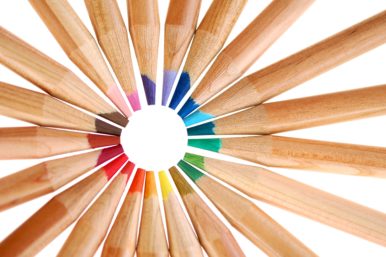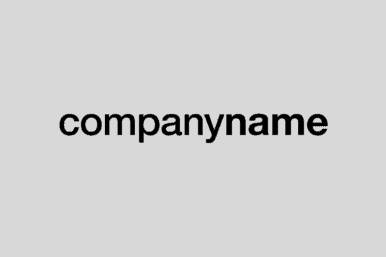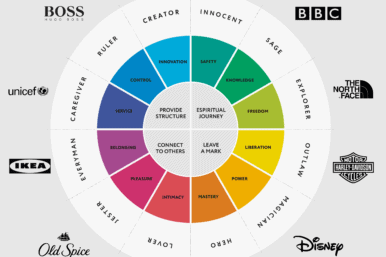Who invented archetypes?
In the 1940s, Swiss psychologist Carl Jung developed a set of common personality archetypes. Jung believed these were innate and hereditary, representing a model image of a person that transcends language, culture and time. As individuals, we can all inherently recognise and relate to the archetypes. They play a role in influencing our behaviour on a subconscious level, leading to typical behavioural patterns, desires, values and motivations all driven by a single dominant goal.
Archetypes are distinct from personas (a word derived from Latin which means ‘mask’), which represents the image we wish to project to the outside world. Our personas are consciously driven constructs which we can control, either projecting from our unconscious archetype or via external influences such as social conventions.
See our post on What are User Personas and why should we use them? to find out how to improve your brand with the science behind personas.
The primary Jungian archetypes are Self, Anima, Animus, Shadow, Persona, Father, Mother, Child, Wise Old, Hero, Trickster and Maiden.
What are the 12 brand archetypes?
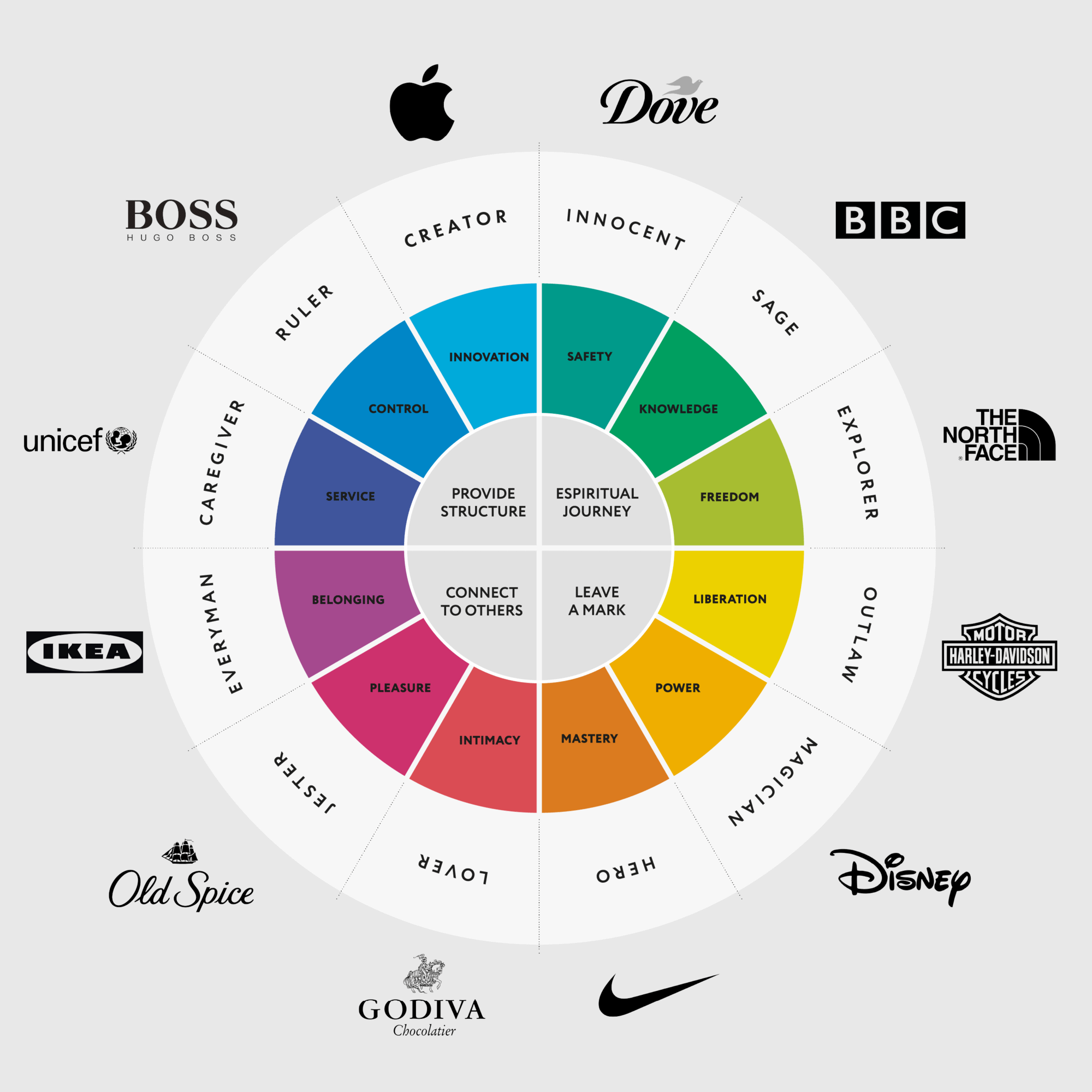
Brand archetypes are derived from Jung’s original set and consist of 12 traits;
- Creator
- Sage
- Caregiver
- Innocent
- Jester
- Magician
- Ruler
- Hero
- Everyman (aka Regular Guy)
- Rebel (aka Outlaw)
- Explorer
- Lover

The creator has a vision and a desire to create an enduring product or experience which realises their vision. They are innovators and non-conformists and are often the first to realise a concept and push the boundaries of creativity and design. They empower others to think creatively and express themselves through the products they produce and the experiences they create.
Desire: Create the perfect product/service
Goal: Innovation
Strategy: Use creativity to solve problems
Brand Message: “Think different”
Traits: Innovation, Originality, Expression, Vision, individualistic
Fears: Stagnation, Duplication, Familiarity, Disillusion, Indifference
Brands: Apple, Lego, Adobe, GoPro, Crayola

The Sage archetype, called ‘senex’ (old man in Latin) by Jung, is a seeker of knowledge and wisdom and believes that truth will set you free. They do not look to change the world themselves but prefer to empower others to do so by seeking out valuable information and sharing it. They are often life-long learners and thought leaders and make excellent mentors.
Desire: Find the Truth
Goal: Understanding
Strategy: Seek information and knowledge
Brand Message: “The truth will set you free”
Traits: Wisdom, Intelligence, Expertise, Information, Influence
Fears: Lies, Misinformation, Ignorance, Inaccuracy, Stupidity
Brands: TED, Google, BBC, Discovery Channel, The Times

Caregivers are driven by compassion and the desire to help others. They want others to feel nurtured and secure and will defend those who are less fortunate than themselves. Caregivers are often maternity figures found in teaching, charity and especially nursing sectors.
Desire: Care, protect and nurture
Goal: Helping Others
Strategy: Do things for others
Brand Message: “Treat others as yourself”
Traits: Compassion, Caring, Reassuring, Nurturing, Warm
Fears: Helplessness, Selfishness, Ingratitude, Instability, Neglect
Brands: Unicef, Johnson & Johnson, NHS, Pampers, Volvo

Brands with an Innocent archetype have a core desire to provide happiness. They are positive and optimistic and actively avoid ill-will towards others. They see the world as wondrous and fun and thrive on passing that feeling on spreading joy where they can. These brands rely on honesty and good virtues and simplicity rather than innovation.
Desire: Love, peace, and happiness for all
Goal: Happiness
Strategy: Do the right thing
Brand Message: “The glass is half full”
Traits: Optimistic, Charming, Honest, Loyal, Simplistic
Fears: Depravity, Deceit, Complexity, Punishment, Confusion
Brands: Dove, McDonald’s, Innocent, Coca-Cola, Volkswagen

The Jester wants to make people laugh and bring light-heartedness to all that they do. Jester brands maintain a playful stance and see good in every situation.
Desire: Enjoy life and have fun
Goal: Entertainment
Strategy: Be playful, be fun
Brand Message: “If you’re not having fun you’re doing it wrong”
Traits: Playful, Humorous, Positivity, Togetherness, Funny
Fears: Boredom, Negativity, Seriousness, Gloom, Misery
Brands: Paddy Power, Budweiser, Skittles, Old Spice, M&Ms

The Magician brand archetype is a visionary that wants to dazzle their audience with new and exciting experiences and make dreams come true. They like to take their followers on a mystical journey and provide them with magical moments that stick in their memory. Magicians savour knowledge but prefer to use it to realise their vision than share it directly with the world.
Desire: Turn dreams into reality
Goal: Magical Moments
Strategy: Create a unique vision and stand by it
Brand Message: “Make the impossible, possible”
Traits: Transformational, Charisma, Imaginative, Idealistic, Insightful
Fears: Repetition, Boring, Stagnation, Doubt, Ignorance
Brands: Disney, Dyson, TUI, Polaroid, MAC Cosmetics

The Ruler is a dominant personality that desires power and control. They love rules, especially when they are able to set them and adhere to them expecting others to follow suit. Rulers are often exceptionally confident, proud of their expertise and possess strong leadership skills. However, they are also trustworthy and stable personalities. They see themselves as the leading force and will aggressively defend their position, fearing being undermined and losing their power.
Desire: Control
Goal: Success
Strategy: Lead and create exclusivity
Brand Message: ”Laughter is the world’s best medicine”
Traits: Power, Status, Success, Wealth, Loyalty
Fears: Losing power, being undermined, rule breakers, rebels, xxx
Brands: Microsoft, Rolls Royce, Rolex, Hugo Boss,

The Hero has a strong sense of right and wrong, looks to make a difference and seeks to overcome injustices and problems. They have a core desire for mastery and inspire others to push themselves. Hero brands portray success through hard work and effort and meet challenges head-on. They are proud that their work sets them apart and see their work as important and empowering.
Desire: Mastery
Goal: Improve the world through courage
Strategy: Motivate and encourage
Brand Message: “Where there’s a will there’s a way”
Traits: Bravery, Courage, Honor, Inspiration, Growth
Fears: Weakness, Incapability, Injustice, Cowardice, Incompetence
Brands: Nike, BMW, FedEx, Adidas, The Royal Marines

Everyman brands are unpretentious, relatable and approachable. They strive to create deep connections with people and long to be liked by all. They are often quite generalised and are driven by a core desire for community and belonging. They hate to stand out and don’t display any extremes of character or opinion preferring to be inclusive. However, though they are often liked this sometimes means they can be easily forgotten.
Desire: Connection with others
Goal: Belonging
Strategy: Down-to-earth and trustworthy
Brand Message: “Live together in harmony”
Traits: Dependable, Realistic, Pragmatic, Inclusive, Equality
Fears: Exclusion, Standing out, Hostility, Isolation, Separation
Brands: Tesco, Lynx, Ford, Levis, Ikea

The Rebel, also known as the Outlaw, seeks to disrupt their industry and challenge the status quo. They actively seek to rip up the rule book and dismantle existing paradigms. The Rebel is happy taking risks in order to create something unique and inspiring and see themselves as free thinkers. They are not appealing to all and often create a cult-like following inspiring very strong brand loyalty amongst a smaller close-knit audience.
Desire: Revolution
Goal: Disruption
Strategy: Shake things up and do things differently
Brand Message: “Rules are made to be broken”
Traits: Disruptive, Liberator, Confrontational, Independent, Change
Fears: Conformity, Rules, Repetition, Rigidity, Status Quo
Brands: Harley-Davidson, Uber, Diesel, Greenpeace, Red Bull

Brands with the Explorer archetype are driven by the desire for freedom and independence and are not restricted by typical boundaries. They are similar to Rebels but tend towards exploration rather than disruption. Explorers hate conformity and prefer to push themselves into uncharted territory where new challenges and goals arise. They are adventurous and brave and are on a continuous journey of discovery.
Desire: Freedom of discovery
Goal: Excitement and Fulfillment
Strategy: Take your own path
Brand Message: “Seek out new things and set yourself free”
Traits: Discovery, Adventure, Independence, Exploration, Pioneering
Fears: Aimlessness, Conformity, Safety, Confinement, Short Sightedness
Brands: NASA, Jeep, The North Face, Subaru, National Geographic

Lovers are passionate and intimate and are motivated by desire. Brands are often sensual and empathetic, motivated to become more emotionally and physically appealing to their audience. However, they can also be spiritual, companionable and family orientated. Their passion can sometimes cloud their focus or be overbearing and sometimes the fear of loss or loneliness can be all consuming.
Desire: Connection
Goal: Intimacy
Strategy: Be desirable
Brand Message: “Love makes the world go round”
Traits: Passionate, Committed, Romantic, Affectionate, Indulgent
Fears: Rejection, Isolation, Loneliness, Unloved, Invisible
Brands: Victoria’s Secret, Godiva, Anne Summers, Alfa Romeo, Chanel
Why are brand archetypes important?
Although brand archetypes have only relatively recently been adopted as a marketing and brand positioning tool, they have existed in narrative art forms for thousands of years and can be found everywhere, from movies to literature and even entrepreneurs and historical figures.
We have Yoda (Star Wars) or Gandalf the Grey (The Lord of the Rings) representing the Sage archetype, King Lear (Shakespeare’s King Lear) or Tony Soprano (The Sopranos) as the Ruler archetype, and Cleopatra (last Egyptian Pharaoh) or Romeo/Juliet (Shakespeare’s Romeo and Juliet) as the Lover archetype.
In storytelling, archetypes are used to create an immediate sense of familiarity between the audience and a character. This is also true of your brand story and this is why brand archetypes are an important marketing tool.
This storytelling mechanism and emotional attachment is the reason that there are some brands that you naturally gravitate towards, brands that make you feel good or give you a buzz when you recognise them. These brands have positioned themselves carefully, creating a persona that connects with you on both a conscious and subconscious level, aligning themselves to a single archetype that best reflects their values and vision. They use the power of their archetype to differentiate themselves from their competitors, building a stronger relationship with you by showcasing their unique personality.
How to determine your brand archetype?
Before defining a brand using archetypes, first, you must consider what is your brand and who is your target market? You need to have a good understanding of how potential customers perceive your company, its products and its services. Also, think about how you would want them to feel about your company.
Brand perception is driven by more than just a rational and logical reaction and, in fact, most of our connection to a brand is driven by our emotions.

You must first get to know your customers and audience by asking questions – face to face interviews, surveys, questionnaires and workshops all work to gather an understanding of what drives their buying decisions, how they feel when they interact with your brand, products or services and how they currently perceive your company. Remember negative responses make just as valuable insights as positive ones.
You then need to interview your brand as if it were a live person. Ask questions of it (realistically this would be the stakeholders) and the responses will enable you to identify which archetype most closely aligns with your brand.
Some example questions are:
- What are your values?
- Which 3 brands do you aspire to?
- Which 3 brands are enemies/opposites to your brand?
- How should you talk to your audience (tone of voice)?
- What emotions do you wish to generate within people when they interact with you?
- What adjectives best describe you?
Don’t forget to interview your own staff as well as customers, especially the key stakeholders. This will highlight any disparity between how your brand is perceived compared to how you feel the brand is positioned internally. If this is the case a decision needs to be made as to how to move forward – do you realign your brand to an archetype as determined by your audience’s perception, or do you stick to your vision and archetype and adjust your target audience accordingly with stronger messaging and a clearer brand position.
Once you have identified the emotional drivers both internally and externally and understand how your brand connects to your audience, you will be able to identify which archetype most closely aligns with your brand.
How to determine your brand personality from your archetype?
An archetype is fundamentally a stereotypical character derived from eons of human experience, representing your brand via human character traits. However, it is too generalised and raw to connect with an audience directly. Once you have determined your archetype you then need to translate this into a brand personality and use this to build connections with your target audience.
A brand personality is a set of human characteristics that are associated with a company brand. It is akin to anthropomorphising a brand and it is the brand personality that an audience relates to and interacts with. It is what makes your business distinct in the eye of your customers and is communicated via brand facets such as brand identity, tone of voice and your various brand touch points.
Various character traits can be attributed to your brand personality and these should be expressed as adjectives as seen from the 12 Brand Archetypes above. For example, the Lover is described as Passionate, Committed, Romantic, Affectionate and Indulgent.
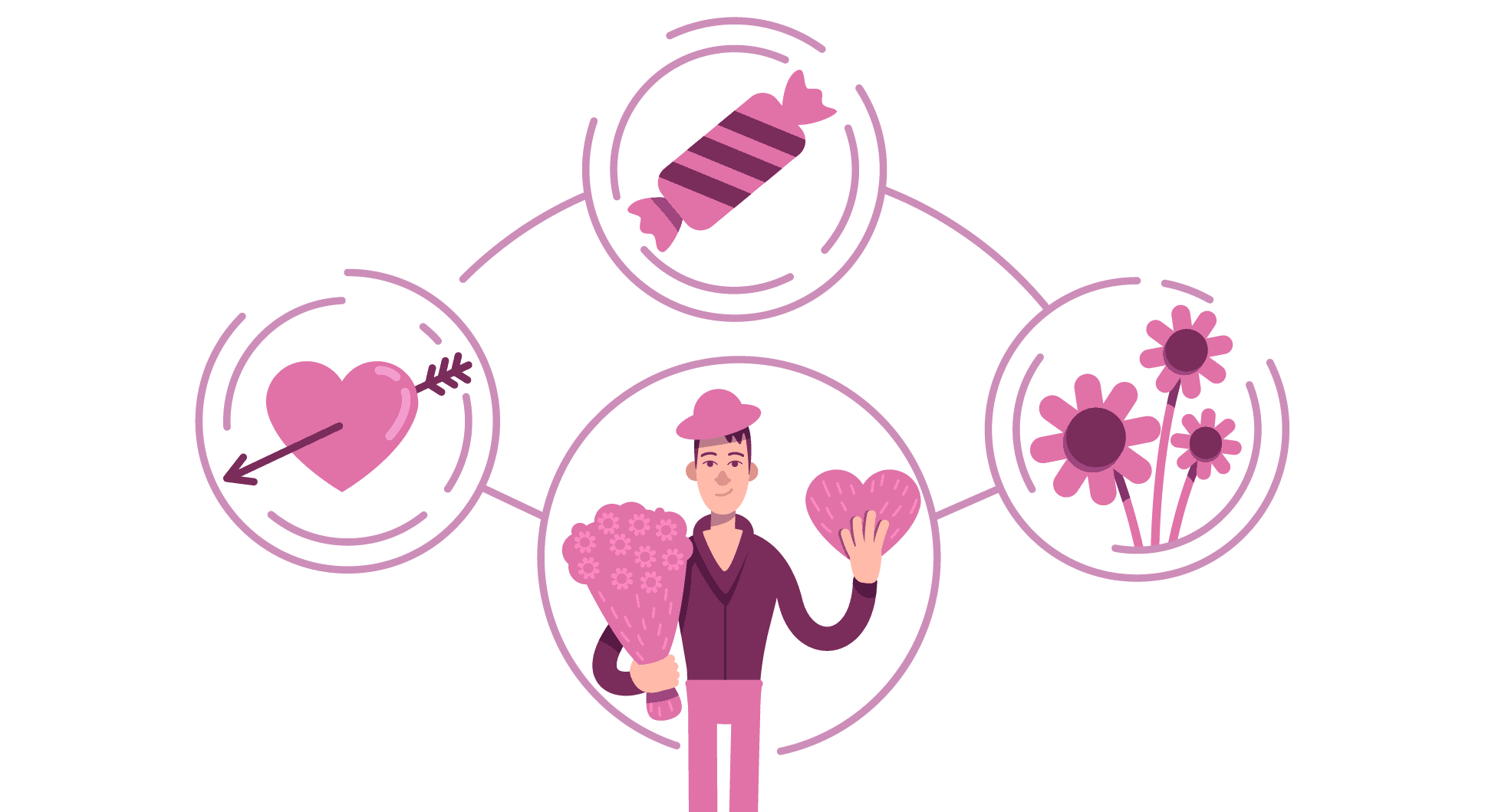
First of all, you need to understand who your key customers’ personas are in order to be able to communicate with them with authority and authenticity. Ask;
- What are the key demographics – age, gender, race etc
- What is their professional background? (If relevant)
- What are their hobbies or interests?
- What are their key motivations and psychographics?
See our post on What are user personas and why should we use them?
Use your brand archetype as the core and, if you need to, add more adjectives to describe your business. It’s ok if you find your brand has associations with a secondary archetype as long as you have defined your primary archetype.
Define 3-5 key adjectives you believe most closely describe your brand. These are the cornerstone of your brand personality.
Build your brand identity and touch points
With your archetype and personality decided you can now start to think about your brand identity and touchpoints. Interaction with your brand personality should elicit a positive emotional response. You can think about how your brand is perceived via our own senses using Sensory Exploration.
Sensory Exploration
Sight: How would the brand look in order to best appeal to your target audience? Think about the colour palette, fonts, iconography, illustration, imagery and form.
Sound: How would your brand sound? Would it be aggressive or soft? Loud or quiet? Smooth or erratic?
Touch: If it could be touched, what would it feel like? Would it be warm or cold? Would it be metal or wood? Soft or sharp?
Let’s say your brand was the Ruler archetype. Your sensory exploration may come up with the following example:
Appearance
Colours: Navy Blue, British Racing Green, Gold.
Form: Strong shapes, hard lines, no soft or rounded corners.
Font: Trajan, Garamond.
Imagery: Sophisticated, Premium, Expensive.
Sound
Loudness: Just below normal speaking volume to instil a feeling of exclusivity and even secrecy.
Timbre: Low; contralto or baritone.
Cadence: Steady.
Touch
Material: Precious metals and high-tech materials such as Carbon Fibre.
Texture: Smooth, cold, luxurious
Smell
Rich leather, premium perfumes and cologne, mahogany, spices.
You can start to build a very visceral image of your brand when you start to associate each of our key senses to realistic attributes, which in turn makes it far easier to imagine how it feels to interact with your brand from a customer’s point of view. We can see what tone of voice we should use, what aesthetics will most appeal and even what sort of photography or video we should use on our marketing materials.
Use brand archetypes to drive success?
Brand archetypes help you determine the human character traits that most accurately reflect your brand. This enables your brand to create deeper connections with your audience and customers based on strong emotional interactions. They help you create an attractive force, pulling and enticing your audience to your brand via shared values, resulting in better brand perception, greater brand advocacy and a stronger, more loyal customer base.
